Cratering
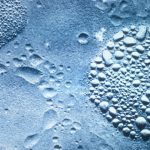
Cratering
Cause
Problems of this nature can be caused by rain falling onto the semi dried coating or aeration/frothing of the paint during application usually by roller and not flowing out properly. Also referred to as pin holes
Solution
Once the coating is completely through dry, flatting down should take place using carborundum (wet or dry) abrasive paper preferably wet – using water/soap or white spirit as a lubricant. Recoat with chosen paint finish.
Pattern Staining

Cause
This colour variation is highlighted where there is a difference in thermal conductivity i.e. the joists and the voids between. Or on internal walls of a timber frame construction highlighting the timber or steel upright studs.
Pattern staining has also occurred where cold water pipes have been chased into the wall before plastering.
Remedy
A paint coating can only improve the aesthetic appearance. To solve the problem the voids between the joists need to be filled with glass fibre or some other type of insulating material .
The illustration showing the pipework can only be rectified by re directing of lagging the pipe.
Cheesiness
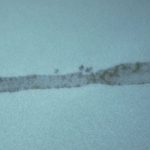
Cheesiness
Cause
A term relating to a freshly applied coating which, when dry, is mechanically weak. This can be as a result of the coating being applied too thickly, incorrect solvent used or wax / grease on the surface which has not been removed before painting. Attention should always be given when painting doors architraves, particularly the lock side, as body fats can be deposited on the surface.
Solution
The coating should be removed and the surface thoroughly washed and flatted down with fine wet or dry carborundum paper. Solvent may be used as a lubricant and cutting agent then repaint as required.
Loss of Gloss
Loss of gloss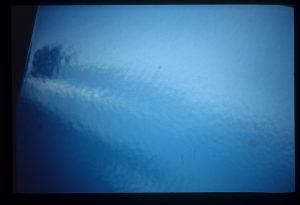
Cause
General loss of gloss caused by moisture or gases coming in contact with the wet or semi-set film during drying. This is particularly noticeable on exterior surfaces such as window sills when the work has been completed late in the afternoon or early evening, when the ambient temperature falls, and dew comes in contact with the surface. Internally, in areas such as kitchens or bathrooms when there is an increase in humidity, i.e. steam before the coating dries.
Also see: Chalking.
Remedy
Flat down and re-paint with a further coat of gloss.
Orange Peel

Cause
This defect mirrors that of an orange peel and is generally due to incorrect paint application by spray or roller.
Remedy
The dry paint film should be flatted down back to a smooth and level surface. Wet or dry carborundum paper, preferably wet, is generally used.
Settlement
Settlement
Cause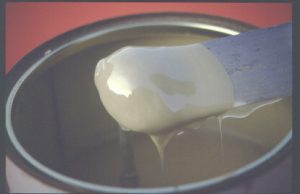
This can occur not only in paint which has been stored for a long time but also in relatively new material, i.e. hard or soft settlement.
Remedy
Thoroughly stir the product and ensure the settled pigment/solids are fully dispersed into the material. Although stirring with a palette knife (broad knife) will generally suffice, mechanical mixing or high speed paint shakers. may be preferred.
Cissing
 Cissing
Cissing
Cause
This defect is caused by a paint coating being applied to a surface which has been contaminated with oil, grease, or polish causing the wet film to creep back exposing the underlying surface. This type of problem can also occur when coatings are applied to surfaces which have previously been treated with a silicone based product, contaminated with body fats including hair sprays etc. In extreme cases where the coating flows back from a large area of the surface, the term crawling is sometime used.
Solution
Once the coating has completely dried and the general adhesion is satisfactory, thoroughly flat down to a smooth surface
using wet or dry carborundum paper wet. After rinsing and ensuring the surface is free from all contaminates re-paint as required.
Mould
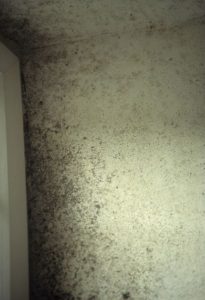
Mould
Cause
Organic mould on an interior wall surface which has penetrated into the plaster caused by damp, humid conditions.
This is generally caused by the lack of airflow within the area by keeping windows and doors closed. Allowing air to circulate freely from humid areas, such as bathrooms and kitchens should be standard practice. It should also be recognised that by turning the heating up, increasing the air temperature, a higher moisture content is held in the atmosphere and when in contact with colder surface condensation can rapidly occur.
The restricted airflow from humid conditions can result in mould forming in corners of rooms and behind household furniture.
Remedy
Allowing air to move freely to escape from humid areas such as bathrooms and kitchens should be standard practice.
It should also be recognised that by turning the heating up, more moisture can be held in the atmosphere and if allowed to settle onto a cooler surface condensation can rapidly occur onto wall surfaces.
Washing down with a solution of bleach and water can help to remove the mould, although proprietary fungicidal solutions may prove to be more effective.
Washing down should not be confined to the affected area but should include all adjacent walls and ceiling areas.
If the organic matter cannot be removed then it may be necessary to “hack off” and re-plaster.
Water Based Paint Flaking
Water based Paint Flaking
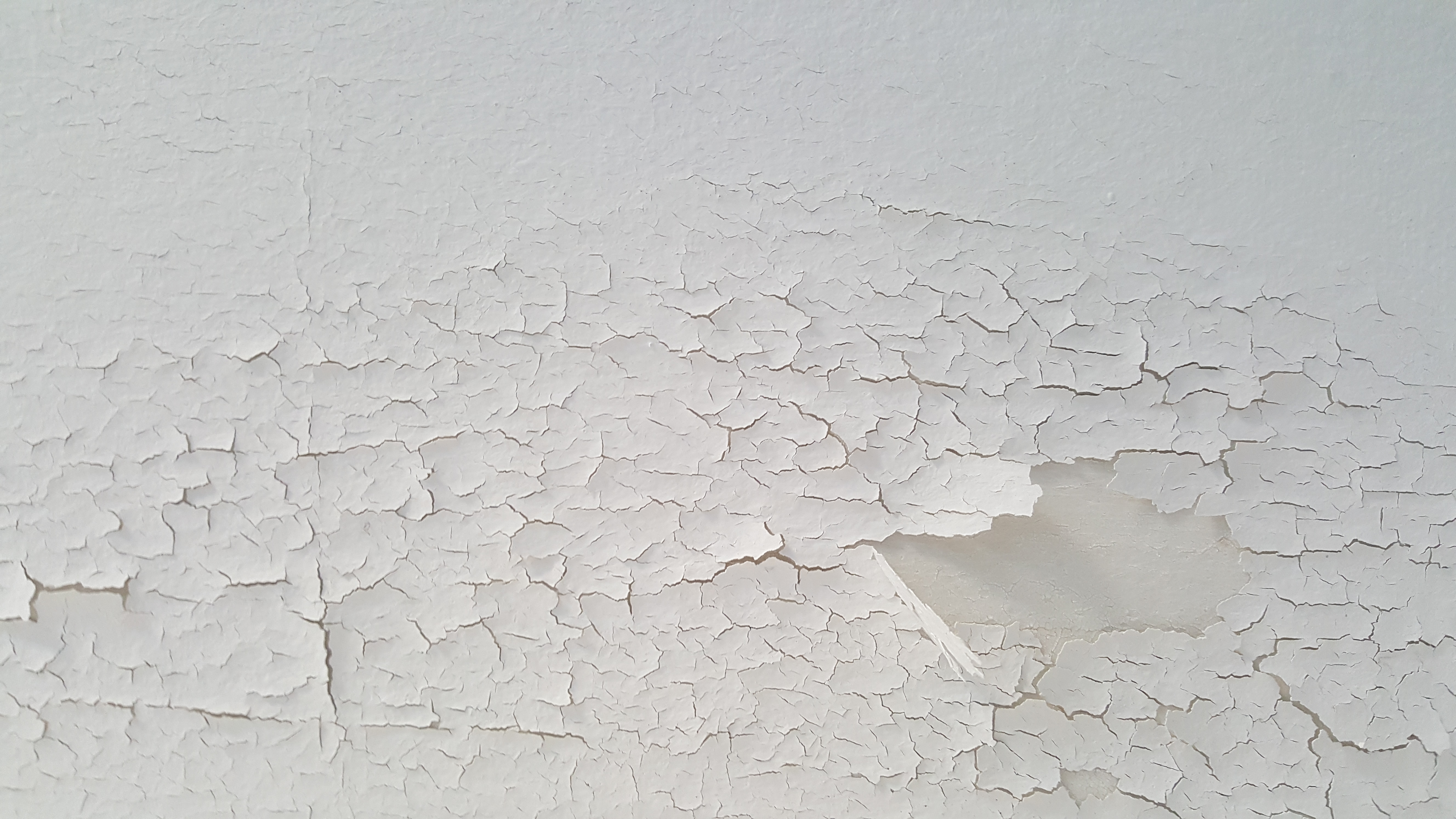
Cause
A breakdown as a result of an emulsion paint being applied over an under-bound material such as distemper.
Solution
Remove completely back to bare plaster by scraping and washing. In some cases the application of a hot glue size over the emulsion can result in blistering occurring and making this coating more easy to remove.
Resin Bleed
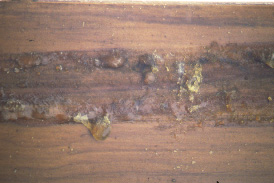
Resin Exudation
Cause
Resin and sap residue is not unusual where knots are present in wood.
A change in temperature can cause the natural resin to be activated and bleed to the surface. The practice years ago was to extract the resin by heat, burning out resinous knots before painting, but today this practice rarely happens.
The hard wood knots can also contain tannic acid which if not sealed will lead to yellowing of light coloured oil based paints.
Remedy
Remove excessive resin with solvent such as white spirit.
For wood translucent finishes sand down and seal all knots with clear shellac (knotting) followed by a conventional alkyd system of primer, undercoat and gloss.
In some cases if the resin in the hard wood veins is excessive, a leafing aluminium based primer should be considered.
Note: While the shellac knotting will reduce the possibility of yellowing it will not stop the resin coming to the surface.
Where the presence of resin is extreme then the only action is to have the timber replaced.